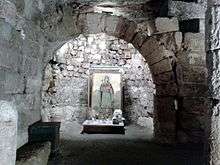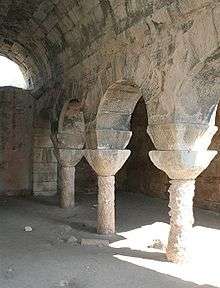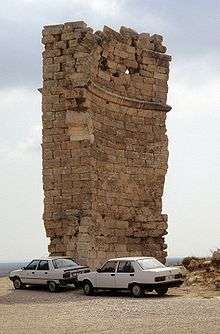Aya Tekla Church



Aya Tekla Church (Ancient Greek: Ἁγία Θέκλα, Hagia Thékla; Turkish: Aya Tekla Kilisesi), also known as Aya Thecla or Aya Thekla, is a ruined historic church of the Byzantine period. It was a popular pilgrimage site, and still attracts visitors today.
Location
Aya Tekla Church is located 4 km (2.5 mi) south of Silifke (ancient Seleucia in Isauria or Seleucia on the Calycadnus) and 85 km (53 mi) from the provincial capital, Mersin. It is situated 1 km (0.62 mi) north of the state highway D-450, which runs parallel to the coast of the Mediterranean Sea.[1]
History
Thecla or Tecla (Ancient Greek: Θέκλα, Thékla) was a saint of the early Christian Church, and a reported follower of Paul the Apostle. She enjoyed great popularity in the Byzantine period. According to the main work about her, Acts of Paul and Thecla, she was originally from Iconion, modern Konya, and after the episodes described in the book, she lived around Silifke and died there.[2]
The beginnings of the site are unclear. A site of Thecla's cult near Silifke was visited by Gregory of Nazianzus in 374. Egeria, a woman widely regarded to be the author of a detailed account of a pilgrimage to the Holy Land, visited the site in 384. She mentioned numerous monastic cells for men and women, and a central church with an enclosing wall.[3] The shrine of Thecla was relocated to a hill, now called Meryemlik, meaning "of Virgin Mary", into a cave, which was supposedly Thecla's home in her later years. The grave in the cave supposedly belongs to her.[2]
Up to 312, Thecla's cave was a secret pilgrimage site. At some date, a church was built into the cave. Aya Thekla, the more prominent church, was built on the hilltop in 460–470 by the Byzantine emperor Zeno the Isaurian (reigned 474–475). The church and other related buildings, such as a bath, are now in ruins, the only standing element being a part of the apse.[2] The cave and cistern to the north of the cave are also partially standing.
References
- ↑ Silifke governor's page (Turkish) Archived October 3, 2011, at the Wayback Machine.
- 1 2 3 Hagia Thekla in Monastic Matrix, Ohio State University
- ↑ M. L. McClure, ed. (1919). The Pilgrimage of Egeria. Society for Promoting Christian Knowledge. pp. 42–43.
Further reading
- Stephen J. Davis (2008). The Cult of Saint Thecla: A Tradition of Women's Piety in Late Antiquity (Oxford Early Christian Studies). ISBN 9780191568350
External links
| Wikimedia Commons has media related to Aya Tekla. |
Coordinates: 36°21′46″N 33°55′51″E / 36.36278°N 33.93083°E